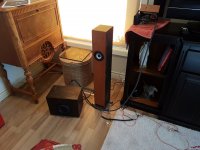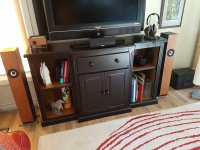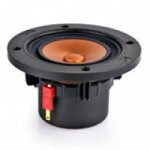Some interesting and great looking TABAQS since I last visited. I built the original design, with original stuffing(100grams) with the W3-315E, I liked what I heard and listened for about 6 months with this set up. Then I decided a bit more bass would be nice. I was going to build another set of TABAQS with a 4” but then I found a small sub woofer design designed by Paul Carmody that used the TB W5-1138. I used a plate amp in the sub design. The TABAQs with this sub design make a nice pair. The 1138 can really belt out the lows if it needs to, for just being 5 1/2” it is amazing. I like this solution as well as I can (to a point tweak the lows) depending on what I am playing. The system as a whole is in a small room but the ceiling reaches 16’ at one point and this system fills the whole room nicely.
Attachments
I do have 4.
Maybe I can stack my Brios on top
One thing, these are the eight ohm versions, right? If 4 ohm, use the 12cm vent.

My Tabaqs all done. Once again thank you so very much Bjorn for the fantastic design!!
Those look great. Are they veneered MDF, solid lumber, or what?
Those look great. Are they veneered MDF, solid lumber, or what?
The bodies are 3/4 inch (18mm) birch ply with walnut veneer. The face is mdf with a 1/4 inch solid walnut cap piece (if that makes sense). The finish is Watco Danish oil wet sanded in with 800 grit wet/dry sand paper and then Johnson Paste Wax on top.
To perceval's question, I ADORE these speakers. I can honestly say that if I wanted something to sound better, I'm looking at room correction steps first before I'm worrying about speakers. The mid-range on the w5-1611 is as good or better than the reviews would have you believe. All together it's a top notch pairing. I have edited down my ramblings about the ribbon tweeter, but I will never use a different tweeter type ever again. Enough said. I have paired the system with a sub (HSU Research STF-) for the last few hz.
When looking at the crossover, I went 4th order for two reasons:
- Time alignment where I could keep the flat front
- Ribbon tweeters (looking at other designs online) just seem to work better that way. I have no real measurement gear so I can't really back up what I've done with my setup. Purely, other people did it that way, so I did it that way and it seems to have worked out better than expected. You may not need to do something that aggressive. I know part of the TABAQ appeal is not having a ton of crossover stuff in the signal path.
That all said, the only "knock" I have against the w5-1611 is that the plastic basket doesn't leave one feeling with the best build quality. I have no issues whatsoever with how it preforms or sounds, but it just doesn't give off "the top shell vibe".
Last edited:
Thanks dasroot.
I've been eyeing that 1611 for a long time, I just might go ahead real soon.
Most people use a 3rd or 4th order on the ribbons because they usually can't take the heat below 1-2kHz. So, when crossing at 3-4kHz, one would need to take down those watts rapidly.
And yes, room correction allows them to shine in your own environment.
Thanks for reporting.
Did you also use a 4th order on the 1611?
I've been eyeing that 1611 for a long time, I just might go ahead real soon.
Most people use a 3rd or 4th order on the ribbons because they usually can't take the heat below 1-2kHz. So, when crossing at 3-4kHz, one would need to take down those watts rapidly.
And yes, room correction allows them to shine in your own environment.
Thanks for reporting.
Did you also use a 4th order on the 1611?
Thanks dasroot.
I've been eyeing that 1611 for a long time, I just might go ahead real soon.
Most people use a 3rd or 4th order on the ribbons because they usually can't take the heat below 1-2kHz. So, when crossing at 3-4kHz, one would need to take down those watts rapidly.
And yes, room correction allows them to shine in your own environment.
Thanks for reporting.
Did you also use a 4th order on the 1611?
Yes, it's crossed at 3600 with a lr 4th order. Thanks for the info!
Thinking of my next TABAQ build possibly using the 4" Pluvia Seven driver from MarkAudio. I am not sure about it's supposed flat response though. Anyone even heard of or considered this driver? Markaudio Alpair-7 Gold Cone 4" Full Range
The specs I can find on it are:
REVC 5.4 Ohm
Fo 70.90 Hz
Sd 5.02 K mm/2
Vas 4.58 Ltrs
Cms 1.27 uM/N
Mmd 3.74 g
Mms 3.95 g
BL 3.83 T*M
Qms 3.07
Qes 0.65
Qts 0.54
Levc 21.30 uH
No 0.24%
Spl
Spl
85.80 dB (with rear cover)
85.20 dB (rear cover removed)
Pwr 20w Nom.
X max 4.2 mm 1 way
Coil Dia 20-mm
Main tolerance +/- 1.5 Hz on mean Fo
These specs are with the cover on.
I have other options with TB drivers (like TB's alot). But thinking about trying out something different in a TABAQ that cost around the $50 range.
The specs I can find on it are:
REVC 5.4 Ohm
Fo 70.90 Hz
Sd 5.02 K mm/2
Vas 4.58 Ltrs
Cms 1.27 uM/N
Mmd 3.74 g
Mms 3.95 g
BL 3.83 T*M
Qms 3.07
Qes 0.65
Qts 0.54
Levc 21.30 uH
No 0.24%
Spl
Spl
85.80 dB (with rear cover)
85.20 dB (rear cover removed)
Pwr 20w Nom.
X max 4.2 mm 1 way
Coil Dia 20-mm
Main tolerance +/- 1.5 Hz on mean Fo
These specs are with the cover on.
I have other options with TB drivers (like TB's alot). But thinking about trying out something different in a TABAQ that cost around the $50 range.
Attachments
Sorry, I didn't mean there was anything wrong with the Pluvia... although some people have demonstrated that the available FR graphs online are not representative of the real life performance. I was just stating that the B80 measures really flat in real life, and true to posted graphs (well, except Qts which mine shows much higher than published specs).
But, the Pluvia's low Fs would probably mean a design change from the original plans. Someone mentioned the Pluvia earlier in this thread, but there was no follow up.
But, the Pluvia's low Fs would probably mean a design change from the original plans. Someone mentioned the Pluvia earlier in this thread, but there was no follow up.
yes, at $90, the B80 is way too expensive. I got mine for about $55.
Then, the RS100-8 from Dayton looks interesting.
Dayton Audio RS100-8 4" Reference Full-Range Driver
Hmmm... I just saw this new driver. It's a coax, and it would be a good fit in the TABAQ Large.
Could be something interesting...
Dayton Audio CX150-8 5-1/4" Coaxial Driver with 1" Silk Dome Tweeter 8 Ohm
Then, the RS100-8 from Dayton looks interesting.
Dayton Audio RS100-8 4" Reference Full-Range Driver
Hmmm... I just saw this new driver. It's a coax, and it would be a good fit in the TABAQ Large.
Could be something interesting...
Dayton Audio CX150-8 5-1/4" Coaxial Driver with 1" Silk Dome Tweeter 8 Ohm
I need to stay at a 4” (size of speaker) needs to stay new or at original TABAQ size do to room. So RS100-8 looks like the one. What about BSC for this, and stuffing? Any change? I can browse the forum if need be. But I’ve seen that you seem to know your way around the TABAQ design Perceval.
I'm no expert, Bjørn is!
I have tested many local drivers in the TABAQ, so I have a little idea of what works and what doesn't.
The RS100 looks good on paper, except for the falling higher end at an angle, so, this drivers has some beaming "tendencies".
Reports earlier on the thread (search for RS100) say that the driver reaches down low, but lacks a bit on the higher end... probably due to the beaming.
Ah! Sorry. I haven't seen the new Dayton offerings, but they do have a 4" version of that coax driver.
You might have a better chance at getting this driver than me. I'd certainly would like to try it. I'll have to ask P-A about the shipping to here.
Dayton Audio CX120-8 4" Coaxial Driver with 3/4" Silk Dome Tweeter 8 Ohm
I have tested many local drivers in the TABAQ, so I have a little idea of what works and what doesn't.
The RS100 looks good on paper, except for the falling higher end at an angle, so, this drivers has some beaming "tendencies".
Reports earlier on the thread (search for RS100) say that the driver reaches down low, but lacks a bit on the higher end... probably due to the beaming.
Ah! Sorry. I haven't seen the new Dayton offerings, but they do have a 4" version of that coax driver.
You might have a better chance at getting this driver than me. I'd certainly would like to try it. I'll have to ask P-A about the shipping to here.
Dayton Audio CX120-8 4" Coaxial Driver with 3/4" Silk Dome Tweeter 8 Ohm
Yep, agreed Bjorn is the expert...
I haven’t built enough to know what could or couldn’t work. Perceval thanks for your input you’ve given me food for thought and another driver to consider. The other one is W4-1337SDF which Bjorn suggested using 60 grams of fill with it.
I haven’t built enough to know what could or couldn’t work. Perceval thanks for your input you’ve given me food for thought and another driver to consider. The other one is W4-1337SDF which Bjorn suggested using 60 grams of fill with it.
Qts on the 1337 is low, but so is the Fs, so it will probably balance it out.
My biggest gripe with the 1337 is the major breakup at 10kHz. Look at the graph, and remember that TB likes to "doctor" their FR graphs... That driver would probably drive me nuts if listened loudly.
I also like TB drivers, but all the ones I tried need help to sound great. They all need some notch filtering to tame a breakup here and there. Easy enough to do with a computer based system or a miniDSP, but screwing in a TB driver on a baffle as is and expecting a flat FR is not going to happen.
My biggest gripe with the 1337 is the major breakup at 10kHz. Look at the graph, and remember that TB likes to "doctor" their FR graphs... That driver would probably drive me nuts if listened loudly.
I also like TB drivers, but all the ones I tried need help to sound great. They all need some notch filtering to tame a breakup here and there. Easy enough to do with a computer based system or a miniDSP, but screwing in a TB driver on a baffle as is and expecting a flat FR is not going to happen.
- Home
- Loudspeakers
- Full Range
- TABAQ TL for Tangband


